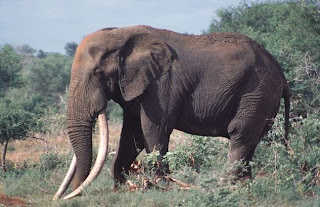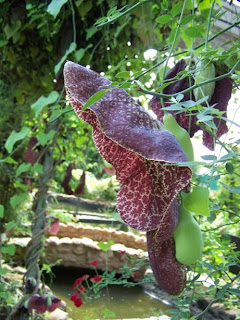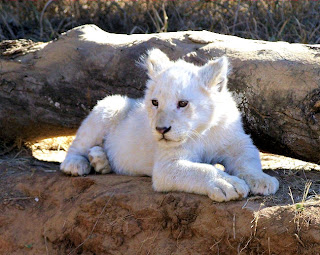
Not much is happening here because of the heat and I will return later, so I head into camp and check myself in for the night. An hour by the pool, a hamburger and coke, and I feel like a million dollars again. I set up camp in a suitable spot next to the fence and need to go for another swim. Four o’clock and I head out to find those elusive elephants. They are here somewhere, I know they are!
Two giraffe are bumping heads in a sparring session. Once again I get fabulous shots as the bush is fairly open here and good for photography. Giraffe have the second longest gestation period of all land mammals, eighteen months. Giraffe and camels have a distinctive walk. Unlike other animals, they move the right side two legs then the left side two legs, where as others use alternate sides. One giraffe is chewing what looks like old buffalo bones which are an additional source of calcium. There is a baby of about a week old. I know if I sit quietly for long enough, it will come closer as they are very inquisitive. Anyone who does wildlife photography knows that the greatest asset in this line of work is patience. I get into position where I am comfortable (using a window mount for my camera), and prepare to wait. The only thing moving are my eyes as I keep track of the youngster and also watch the continuing battle between the two males. Forty five minutes goes by, they have forgotten I am here, but the baby has started to edge closer and is now halfway between its mother and the car.  Then I smell it…….the unmistakable smell of elephant! They are so quiet, walking on their toes, that one always smells them first. The giraffe are forgotten and I whip around looking for the elephants. The giraffe flees back to the comfort of mom’s side and I see a small movement behind some bushes. Yes, there he is. A big bull about to pull a branch down off a tree. These mammals must eat in the region of 300kg per day, this includes bark, leaves and grass. What an enormous male he is. I get the camera going. He is about 20 yards away. His tusks are huge and he must be at least in his 60’s. I try to see if he has mates but cannot find another one, but that does not mean they are not there, just that I cannot see them for now. The males are usually loners or with two or three other males. They only join the female herds for mating periods and believe me when I say this is quite a sight to see. On the rare occasions when I have, I actually forgot to take pictures!! He finishes his branch and reaches up for another coming more into the open and closer to the car. I hear something in the bushes on the other side and turn to find another bull not ten yards away coming straight in my direction.
Then I smell it…….the unmistakable smell of elephant! They are so quiet, walking on their toes, that one always smells them first. The giraffe are forgotten and I whip around looking for the elephants. The giraffe flees back to the comfort of mom’s side and I see a small movement behind some bushes. Yes, there he is. A big bull about to pull a branch down off a tree. These mammals must eat in the region of 300kg per day, this includes bark, leaves and grass. What an enormous male he is. I get the camera going. He is about 20 yards away. His tusks are huge and he must be at least in his 60’s. I try to see if he has mates but cannot find another one, but that does not mean they are not there, just that I cannot see them for now. The males are usually loners or with two or three other males. They only join the female herds for mating periods and believe me when I say this is quite a sight to see. On the rare occasions when I have, I actually forgot to take pictures!! He finishes his branch and reaches up for another coming more into the open and closer to the car. I hear something in the bushes on the other side and turn to find another bull not ten yards away coming straight in my direction.
 Then I smell it…….the unmistakable smell of elephant! They are so quiet, walking on their toes, that one always smells them first. The giraffe are forgotten and I whip around looking for the elephants. The giraffe flees back to the comfort of mom’s side and I see a small movement behind some bushes. Yes, there he is. A big bull about to pull a branch down off a tree. These mammals must eat in the region of 300kg per day, this includes bark, leaves and grass. What an enormous male he is. I get the camera going. He is about 20 yards away. His tusks are huge and he must be at least in his 60’s. I try to see if he has mates but cannot find another one, but that does not mean they are not there, just that I cannot see them for now. The males are usually loners or with two or three other males. They only join the female herds for mating periods and believe me when I say this is quite a sight to see. On the rare occasions when I have, I actually forgot to take pictures!! He finishes his branch and reaches up for another coming more into the open and closer to the car. I hear something in the bushes on the other side and turn to find another bull not ten yards away coming straight in my direction.
Then I smell it…….the unmistakable smell of elephant! They are so quiet, walking on their toes, that one always smells them first. The giraffe are forgotten and I whip around looking for the elephants. The giraffe flees back to the comfort of mom’s side and I see a small movement behind some bushes. Yes, there he is. A big bull about to pull a branch down off a tree. These mammals must eat in the region of 300kg per day, this includes bark, leaves and grass. What an enormous male he is. I get the camera going. He is about 20 yards away. His tusks are huge and he must be at least in his 60’s. I try to see if he has mates but cannot find another one, but that does not mean they are not there, just that I cannot see them for now. The males are usually loners or with two or three other males. They only join the female herds for mating periods and believe me when I say this is quite a sight to see. On the rare occasions when I have, I actually forgot to take pictures!! He finishes his branch and reaches up for another coming more into the open and closer to the car. I hear something in the bushes on the other side and turn to find another bull not ten yards away coming straight in my direction.This elephant is HUGE. My car almost fits under his belly! I sit as still as I can, camera forgotten (again) he is closer. I look up into his mouth as he passes right in front of me to join his companion. Camera! Grab the camera! At last I get the shots I am waiting for. He joins the other elephant and the two start grazing on the grass not ten yards away. Thank goodness I have a quiet camera! They sure do smell and as fast as they put food in their mouths, it all comes out at the back. They move slowly away and I start to breathe again. Ten minutes later they are gone from sight, but I know they are still close by. The giraffe have all but gone too and I decide to move on. My first sighting of elephant has been good and hopefully there will be many more before this trip is over.


Part three coming soon……..


 The first thing I see is impala. They are a medium size antelope and there are about 28,000 of them in the park. They are the favorite prey of cheetah and leopard and it is beneficial to watch the herds as they will give you a good indication if predators are around. The females all gave birth in November and December, so there are plenty of young ones around who are very actively jumping and running around in the cool of morning. Later on, they will be under the trees trying to find a cool shady spot to stay in until the sun goes down. But for now it is amusing to watch their antics. I feel very sorry for the males as they only have a six week period in June/July when they mate with the females, then they run around most of the time chasing other males away and this does not allow them much mating time. However, they seem to get the job done eventually, but by the end of this time, actually have black rings around their eyes from fatigue! What an advantage us two-legged creatures have!
The first thing I see is impala. They are a medium size antelope and there are about 28,000 of them in the park. They are the favorite prey of cheetah and leopard and it is beneficial to watch the herds as they will give you a good indication if predators are around. The females all gave birth in November and December, so there are plenty of young ones around who are very actively jumping and running around in the cool of morning. Later on, they will be under the trees trying to find a cool shady spot to stay in until the sun goes down. But for now it is amusing to watch their antics. I feel very sorry for the males as they only have a six week period in June/July when they mate with the females, then they run around most of the time chasing other males away and this does not allow them much mating time. However, they seem to get the job done eventually, but by the end of this time, actually have black rings around their eyes from fatigue! What an advantage us two-legged creatures have!
 I see beautiful Starlings feeding and come across some ground Hornbills. They are the largest of the hornbill species and stand at about a metre tall. They are black with a bright red crop. The crop is yellow (almost white) when born, turning orange and then red as they grow older. They walk along the road looking for insects, snakes, centipedes and I have even seen them trying to get at a tortoise. Stunning creatures with very long eyelashes, they are wonderful to see.
I see beautiful Starlings feeding and come across some ground Hornbills. They are the largest of the hornbill species and stand at about a metre tall. They are black with a bright red crop. The crop is yellow (almost white) when born, turning orange and then red as they grow older. They walk along the road looking for insects, snakes, centipedes and I have even seen them trying to get at a tortoise. Stunning creatures with very long eyelashes, they are wonderful to see.



























